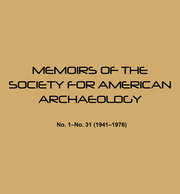Article contents
Corn and Cucurbits from Wetherill Mesa1
Published online by Cambridge University Press: 27 June 2018
Abstract
Most corn from the Mesa Verde area belongs to a complex derived from hybridization of a small-cobbed flint-pop corn with an 8-rowed flour corn. This cross produced 12- to 14-rowed flint and flour corn (the typical Basketmaker corn) and the variable Pima-Papago corn. After Pueblo I, probably late Pueblo II, there was an increase in the number of 8-rowed cobs and a decrease in 12- to 14-rowed cobs. The corn is similar to collections from sites of comparable age excavated in northern Arizona near Navajo Mountain. The uniformity and the slow development of corn types probably reflect peripheral conditions, especially adaptation to short growing seasons and limited cultural interchange.
Practically all of the squash was Cucurbita pepo, the species which spread over all agricultural areas of the United States. There were a few specimens of Cucurbita mixta and of the bottle gourd, Lagenaria siceraria. Some rinds of the two species of Cucurbita gave evidence of their use for scrapers and containers, uses to which the bottle gourd is put almost exclusively in sites to the south. The rarity of the bottle gourd and the absence of seeds and plant parts of cotton suggest that these plants were rarely, if ever, grown in the region.
- Type
- 3 The Natural Sciences
- Information
- Memoirs of the Society for American Archaeology , Volume 19: Contributions of the Wetherill Mesa Archeological Project , October 1965 , pp. 136 - 152
- Copyright
- Copyright © Society for American Archaeology 1965
Footnotes
This is Contribution No. 31 of the Wetherill Mesa Archeological Project.
References
- 5
- Cited by


